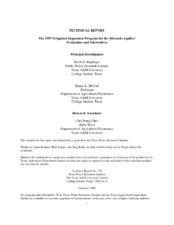| dc.description.abstract | The EAA implemented a pilot irrigation suspension program in 1997 on 9,669 acres mainly in Medina and Uvalde counties with the objective of increasing springflow at Comal Springs, and providing relief to municipalities in meeting Critical Period (drought) Management Rules. The Aquifer region, however, experienced a wet Spring in 1997, so that even irrigators not enrolled in the program applied little or no irrigation water. If conditions were dry in Spring 1997, aquifer simulation results indicate that suspending irrigation on enrolled acreage would have reduced pumping by 23,206 acre-feet and would have augmented Comal springflow by 6,498 acre-feet during the program year and by 17.7 cfs in August. The level of the eastern portion of the Aquifer would have been expect to rise by about 3.8 feet, and the cost per acre-foot of suspended irrigation would have been about $99. Payments to irrigators totaled $2,350,000.
The ISP Program did cause farmer adjustments. Participants in the ISP program planted less corn, cotton, vegetables, and peanuts in favor of more sorghum and wheat. Irrigators who converted to dryland purchased somewhat less fertilizer, seed, and labor, but secondary effects on the local economy appeared to be small.
The price paid per suspended acre was much higher than regional lease rates and average cropping profit margins in many instances. Factors which may have accounted for the high bids include: 1) lack of experience with an ISP, 2) its late start up, 3) the belief that bids might affect future water prices or offers, 4) tendencies to bid high enough to cover costs under a worst case scenario of a total loss of dryland crops, 5) collusion and need to bid high enough to compensate all under current land lease arrangements. Bids in future ISP solicitations might be lower, or might not. Given the substantial difference between local irrigated land rental rates and ISP bids, it seems unlikely that the EAA could attract sufficient acreage by capping bids at rental rates. There may be, however, some latitude for the EAA to set a maximum per acre rate somewhere between local rental rates and the ISP bids. This, combined with announcing the program and executing contracts in October or November, has the possibility of substantially reducing program cost.
The EAA may also want to consider offering an option contract which when implemented would suspend irrigation in April or May. Waiting until April or May would provide the EAA more information on current year weather allowing better information on whether irrigation suspension is really necessary since: 1) more time would have elapsed allowing administrators to know Aquifer elevation at a later date, and 2) information of weather, irrigation use to date and projected irrigation for the remainder of the cropping year is increased this point. The cost of a single implementation of such a program may be substantially higher than a January 1 contract, since irrigators may sustain greater loss. Expected program cost, however, could be lower, since this option would be exercised less frequently, offsetting over higher cost of implementation.
Good alternatives to an ISP are limited. We evaluated the potential of 1) implementing more efficient irrigation technology and 2) buying land and leasing it back during wet or average years. The ISP is a more cost effective source of critical water than is the use of subsidized irrigation efficiency largely because the ISP can put in place only when water is needed. Also, while not considered here, evidence in areas such as the High Plains suggests that irrigator pumping is not reduced by the amount an increase in irrigation efficiency would imply. This is because irrigators may choose to irrigate more water intensive crops and/or irrigate more acreage when efficiency is increased. The high bids experienced in the 1997 program compared to price of land in the Aquifer region suggests that a buy-leaseback arrangement could substantially reduce the cost to the EAA of suspending irrigation. This, of course, would require an alternate set of administrative costs by the EAA and may be less expensive than the ISP. Also the picture may be altered by the adjudication of water rights in the Aquifer which will likely be finished within three to five years. After water rights adjudication, however, buying and leasing back water rights may be a very appropriate and cost effective strategy for the EAA.
In sum, we conclude that the 1997 pilot ISP was a reasonable response to the drought condition experienced in 1996. Fine-tuning the selection criteria, bid arrangement, allowing greater lead time, and/or implementing an ISP or option contract later in the year, holds the potential for reducing the cost of program implementation.
A land-based ISP is an interim arrangement that can be implemented in the absence of a fully functioning permit system. After water rights are adjudicated in the region, ISP and option contracts will take on more conventional forms involving buy, lease, and option contracts for water rights. It is expected that water-based versus land-based arrangements would likely facilitate the transfer of water at lower rates. | en |


